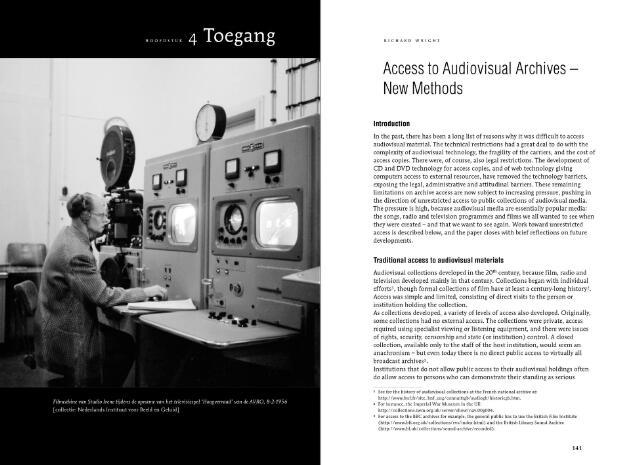4 Toegang
Access to Audiovisual Archives -
New Methods
Introduction
In the past, there has been a long list of reasons why it was difficult to access
audiovisual material. The technical restrictions had a great deal to do with the
complexity of audiovisual technology, the fragility of the carriers, and the cost of
access copies. There were, of course, also legal restrictions. The development of
CD and DVD technology for access copies, and of web technology giving
computers access to external resources, have removed the technology barriers,
exposing the legal, administrative and attitudinal barriers. These remaining
limitations on archive access are now subject to increasing pressure, pushing in
the direction of unrestricted access to public collections of audiovisual media.
The pressure is high, because audiovisual media are essentially popular media:
the songs, radio and television programmes and films we all wanted to see when
they were created - and that we want to see again. Work toward unrestricted
access is described below, and the paper closes with brief reflections on future
developments.
Traditional access to audiovisual materials
Audiovisual collections developed in the 20th century, because film, radio and
television developed mainly in that century. Collections began with individual
efforts1, though formal collections of film have at least a century-long history2.
Access was simple and limited, consisting of direct visits to the person or
institution holding the collection.
As collections developed, a variety of levels of access also developed. Originally,
some collections had no external access. The collections were private, access
required using specialist viewing or listening equipment, and there were issues
of rights, security, censorship and state (or institution) control. A closed
collection, available only to the staff of the host institution, would seem an
anachronism - but even today there is no direct public access to virtually all
broadcast archives3.
Institutions that do not allow public access to their audiovisual holdings often
do allow access to persons who can demonstrate their standing as serious
RICHARD WRIGHT
1 See for the history of audiovisual collections at the French national archive at:
http://www.bnf.fr/site_bnf_eng/connaitrgb/audiogb/historicgb.htm.
2 For instance, the Imperial War Museum in the UK:
httpcollections.iwm.org.uk/ server/show/ nav.00g004.
3 For access to the BBC archives for example, the general public has to use the British Film Institute
(http://www.bfi.org.uk/collections/rvs/index.html) and the British Library Sound Archive
(http://www.bl.uk/ collections/sound-archive/recorded)
141

